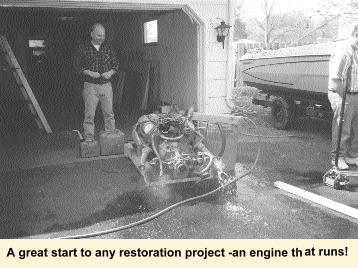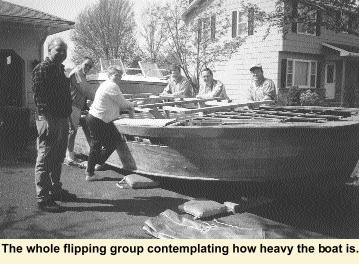by Sherwood Heggen
Fourteen years ago, BSLOLer Bob Buttery, bought his first wooden boat, a 1958 Century Resorter 19. The boat had been in the water when he bought it and seemed in pretty good shape; it would only need a little work. The transom had only a little rot and the decks needed some repair. The bottom looked good, appearing to need only some bilge paint. Bob had been bitten by the wooden-boat bug and he was on his way to restoring a his own woodie.
Bob started the restoration process the correct way by making sure the engine runs. He hooked up water, gas, and a battery and found he had nothing to do but to clean and paint the engine. The engine ran great. Sadly, that is as far as he got on his restoration project in all these years. To keep the spirit alive and the engine loose, Bob has run the engine regularly. It was that irreverent robber of time that kept Bob from his real joy. Yes Bob, being self-employed, was a slave to making a living and the boat had to sit.
 During this past year, Bob found some time to do the transom repairs and things seemed to look pretty good towards getting a finish on the hull. The bottom appeared to be in pretty good shape and excitement of getting this boat on the water was getting more intense. The excitement died, however, as Bob was moving about in the boat and his foot went through the garboard plank near the shaft hole. Right then, a change in restoration plans came to mind. The boat would have to be rolled over to replace the bottom.
During this past year, Bob found some time to do the transom repairs and things seemed to look pretty good towards getting a finish on the hull. The bottom appeared to be in pretty good shape and excitement of getting this boat on the water was getting more intense. The excitement died, however, as Bob was moving about in the boat and his foot went through the garboard plank near the shaft hole. Right then, a change in restoration plans came to mind. The boat would have to be rolled over to replace the bottom.
Being an avid reader of The Boathouse, Bob saw an article about how to roll over a boat which was very timely according to his need. He called on the author of that article to lead in the process to be sure everything went right. To match the described process, Bob assured me there would be pizza for those who came to help. Bobs wife Karen also insisted that my wife Jo join the event. This would be more like a barn-raising in the old days, i.e. get the neighbors together to work and then everybody eats.
When we arrived, we were greeted by warmly Bob and Karen. Other helpers, Greg Benson and Al Lindquist, were hovering about the boat all ready to go. Two other men from the neighborhood came to lend a hand.
 To get everybody in the boat mood, Bob hooked up to water, gas, and a battery to the engine for this boat and hit the starter switch. The enthusiasm level rose dramatically as the engine rumbled to life. It was a sound everyone was attracted to, men and women alike. The only thing wrong with the scene was the motor was on a test stand and the boat was a long way from floating. It was time to flip the boat.
To get everybody in the boat mood, Bob hooked up to water, gas, and a battery to the engine for this boat and hit the starter switch. The enthusiasm level rose dramatically as the engine rumbled to life. It was a sound everyone was attracted to, men and women alike. The only thing wrong with the scene was the motor was on a test stand and the boat was a long way from floating. It was time to flip the boat.
Bob had built bracing into the hull that the boat would rest on when upside down. He also had a frame with wheels on it which would allow us to move the boat into the garage after we our deed was done.
The time had come to roll this 19 monster over. Some last minute instructions were given, cushions were positioned, and the lifting began. The port side began to rise and with a little effort, the boat was sitting on its starboard side. While a couple of men balanced the boat, others switched over to the deck side to let the boat down gently on the wheeled frame. It was over, almost uneventfully. We pushed the boat into the garage and stood around chit-chatting about the condition of the bottom while we waited for that pizza we were promised.
The pizza wasnt coming for a while so we asked for some screw drivers. We might as well remove some bottom planks while we were there to give Bob a head start on his project. It wasnt long before we were removing bottom planks – and guess what we found? More problems. Knees and bottom frames were broken and the chine was gone. Well, it was there, but not as much of it as we wanted to see. Rot had definitely taken its toll on the bottom frame. There was no question as to what needed to be done – replace every questionable part. Oh yes, the pizza did come and it was very good. Thanks, Bob and Karen!
The important part of this article is that you, as a restorer, should never take for granted the condition of any part of your project. The boats we own were not built to have a life span of 40 or 50 years. Why should we think that the wood could still be as good as new 40 or 50 years later?
If you have a restoration project under way, give a lot of consideration to what else could be wrong with the boat. It is so easy to replace parts when everything is opened up. It is important that one pays attention to these details. Your boating pleasure and your safety are at stake. Also, think of protecting your boat which depends upon you for its life. Once again, let me remind you .Dont destroy it; restore it!

